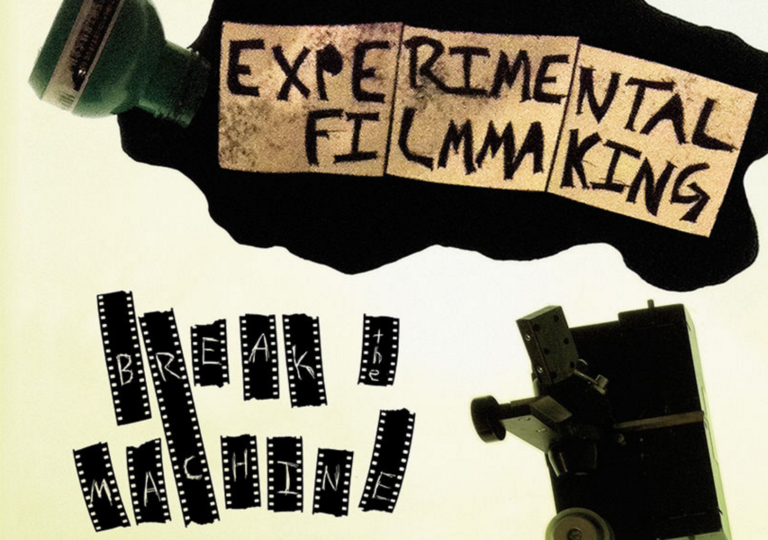Sign up for the
TSL Newsletter
and get $50 off Final Draft 12
By Staff · November 19, 2015

Editor's Note: We receive a considerable amount of inquiries from filmmakers searching for resources beyond the script. While we cannot address all of the non-screenwriting questions we get, we’re always on the lookout for new resources to recommend. Our latest find: Kathryn Ramey’s new book, Experimental Filmmaking: Break the Machine.
Film is dead – or so it goes. Of course, that’s not really true. After all, good old-fashioned film stock remains the medium of choice for just about anyone who can afford it. SPECTRE, Star Wars, and The Hateful Eight, arguably the three most anticipated movies of the holiday season, are all shot on film. And even as that number decreases year over year, it’s unlikely that the format will ever disappear entirely. The forced transition to digital is admittedly an artistically lamentable one, not because digital is lacking as an aesthetic (it isn't, especially in the hands of a master), but rather because it's entirely driven by financial considerations (usually a bad thing when it comes to art). It's no surprise that so many young filmmakers sing the praises of digital cinema, and yet many remain vocal about the fact that, if presented with the choice, they'd jump at the opportunity to work with celluloid. The unfortunate truth of the matter is that such a choice has become rare to non-existent.
So, “film is dying” is more like it. And whether or not it endures will depend on more than just a couple of high-profile blockbusters each year. For proponents of the the old-school way of doing things, an effort has been made to re-define movies shot and projected on film as a sort of “premium” viewing experience. Large formats (70mm and IMAX, in particular) are presented as the way to experience a movie, and admittedly, they are. Take last year’s IMAX presentation of Interstellar, for example. Or better yet, take Lawrence of Arabia. Experiencing a film of the magnitude projected in glorious 70mm is a different kind of beast altogether. Even in quantifiable terms, the photochemical process arguably still produces the richest, most detailed images we can achieve. Of course, for most of us, if shooting 35mm is already a challenge, then 70mm is a pipe dream at best. The question then becomes how can we use the photochemical process to bring something unique to projects shot on 16 or 35mm film that can’t be achieved via some slider in Adobe After Effects. If that’s a question that interests you, as it does me, you might want to check out Kathryn Ramey’s comprehensive new guide, entitled Experimental Filmmaking: Break The Machine.
From the different types of film stock to the numerous development methods, Ramey's book is conveniently broken into chunks, with each section dedicated to outlining specific techniques in great detail. Part history textbook, part how-to guide, the sections also feature in-depth interviews with experimental filmmakers who have had managed to mold careers out of their work with film formats. A particularly intriguing side-note is the fact that neither the author nor the interviewees deny the virtues of digital cinema. In fact, the final chapter embraces the trend by exploring “glitches” and other techniques designed to manipulate digital images in fascinating ways. Ramey's agenda, if indeed she has one, is simply to explore all the creative possibilities at play in something as deceptively simple and seemingly throw-away as the choice to shoot on film over digital or vice versa.
The most fascinating recurring theme of the book is a sort of a rephrasing of the classic Marshall McLuhan thesis: the medium is the message. From beginning to end, Break the Machine returns to the idea that there is an intrinsic connection between form and narrative, or to put it more simply, between what you're saying and how you're saying it. In one of the book's aforementioned interviews, Jenny Perlin, a filmmaker specializing in installation art, discusses the various twentieth century ideas at the core of her work, which to her seemed particularly well suited to the tactile and mechanical quality of celluloid projected the old fashioned way. Likewise, I can think of several notable films that use the aesthetic of digital cinematography to enhance story and atmosphere (Michael Mann’s Collateral comes to mind).
There’s a definite DIY approach to each section that works wonders in breaking down the experience-gap that so many new filmmakers feel when considering the viability of film stock for their next project. It's all here – from the ins and outs of the photochemical process; to optical printing; to constructive and deconstructive techniques. The book is a solid technical guide for understanding the experimental possibilities of film formats, and for filmmakers with limited exposure to actual film (an ever-increasing number of us), these experimental techniques might just be enough to spark an idea or two.
Where to Buy It? Experimental Filmmaking: Break the Machine by Kathryn Ramey is available on Amazon.com. Click here to purchase.